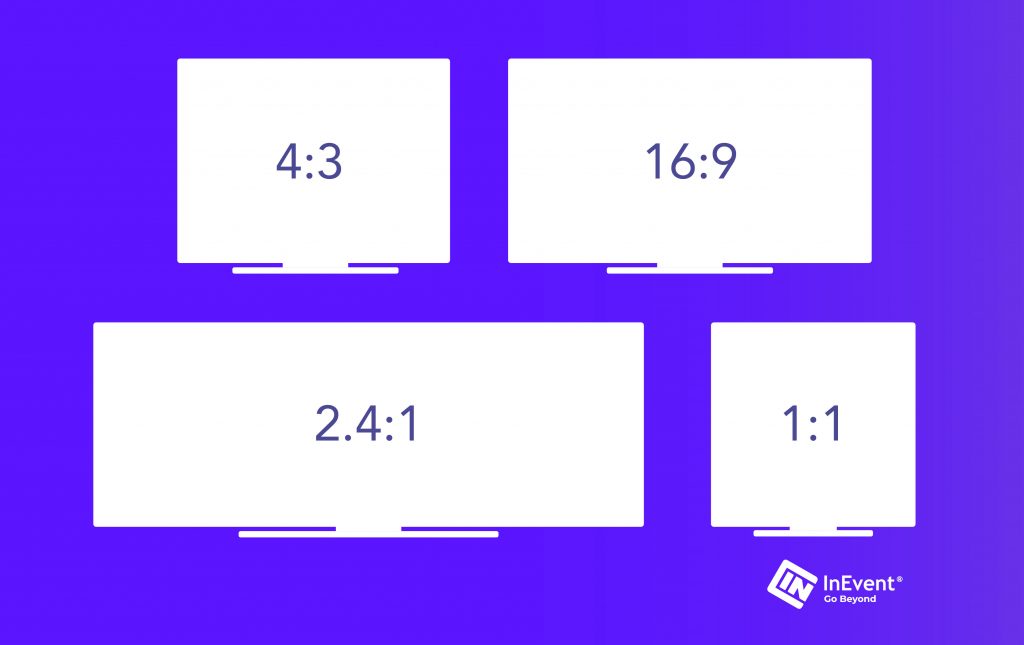Understanding Video Aspect Ratios
Video Aspect ratios are essential in any video content. The video aspect ratio determines the experience your viewers can have from the platform on which content is displayed. Furthermore, video aspect ratios and resolution work together to determine the streaming quality for users on any video streaming platform, whether live streaming, over-the-top (OTT) app or website. This post will explain everything you need to know about video aspect ratio.
What is Video Aspect Ratio?
Aspect ratio is the proportion of an image’s width to its height. Video aspect ratio measures how wide your video is. The most common aspect ratios for movies and television are 1.85:1 and 4:3. However, with the rise of digital video, various aspect ratios have become popular.
Take a look at the few below and their connotations:
2.4:1 – Ultra widescreen
16:9 – Widescreen
4:3 – Standard
1:1 – Perfect Square
The resolution and the frame rate determine a video’s aspect ratio. Resolution is measured in pixels and refers to the number of horizontal pixels in an image. A pixel is a small color square that makes up the image on your screen. The more the pixels, the higher the resolution, and the better the image quality. And the higher the resolution, the crisper and more detailed the image.
Frame rate is the quantity of frames shown per second in a video. This is measured in Hertz (Hz). Generally, a higher frame rate produces a smoother appearance. However, increasing the frame rate also increases the video’s file size and processing requirements.
Aspect ratio and resolution
Aspect ratio and resolution are inextricably linked. To calculate the resolution, multiply the width by the height. To calculate the aspect ratio, divide the width by the height. You get the aspect ratio when you divide the resolution by the frame rate. For example, if an image has a resolution of 1280 x 720 pixels and a frame rate of 24 fps, the aspect ratio would be 1280/24 or 5:3. If you have a 16:9 aspect ratio screen, for example, you’ll want to set your device’s resolution to 1920×1080 to take advantage of all the available pixels. If you have a 4:3 aspect ratio screen, on the other hand, you’ll want to set your device’s resolution to 1024×768 to make use of all the available pixels.
There are some exceptions to this rule – for example, many devices now offer a “retina” resolution that is twice as high as the standard resolution. This is because retina screens have a higher pixel density, meaning more pixels per inch on the screen. This allows for a sharper image and greater detail.
Most Common Aspect Ratios

There are different aspect ratios used in digital video. Below are some of the most common ones:
4:3
The 4:3 aspect ratio has been around for a long time and is still used in many different applications. It was first used in the 1920s and remained popular until widescreen formats became popular in the 1950s. TV shows and movies are typically shown in this aspect ratio, as it’s considered more natural looking than the 16:9 aspect ratio.
Some people believe that the 4:3 aspect ratio is better for watching video content because it fills more of the screen without any black bars on the top and bottom. However, others feel that the 16:9 aspect ratio is better because it provides a more immersive experience.
3:2
3:2 is a classic aspect ratio. This ratio has been used in photography and filmmaking for decades and is still a popular choice today. There are a few reasons why 3:2 is so popular. For one, it’s relatively straightforward. It’s also versatile, meaning it can be used for various purposes. And finally, it produces pleasing results aesthetically.
16:9
The modern widescreen aspect ratio is becoming increasingly popular due to its ability to display more information on-screen than 4:3. It is the aspect ratio of most TVs and computer monitors. This ratio is likely used for video creation and streaming today because the 16:9 ratio is considered the international standard format for television, cinema, and major online streaming setups and platforms.
21:9
The 21:9 aspect ratio is slowly gaining popularity thanks to its ability to offer a more immersive viewing experience. With a 21:9 aspect ratio, movies and TV shows can be viewed entirely without any black bars at the screen’s top and bottom positions. This is especially beneficial for those who want to watch widescreen content on a widescreen display.
Of course, all content is not created equally, and not all content will look good when displayed in 21:9. To get the most out of your 21:9 aspect ratio display, you’ll want to stick to watching movies and TV shows that have been formatted explicitly for that aspect ratio. Thankfully, more and more of these types of videos are becoming available all the time.
If you want to get the most out of your 21:9 aspect ratio display, check out some of the content formatted for it.
9:16
There’s something special about the 9:16 aspect ratio. It’s an unusual but perfect size for a smartphone screen, and it feels natural to hold in your hand. Plus, it leaves enough room for menus and other on-screen controls without feeling too cramped.
A few years ago, nearly every phone had a 4:3 aspect ratio. But as screens got bigger and resolutions improved, 16:9 became the new standard. This is great for watching videos but can be a bit awkward for everyday tasks like browsing the web or checking your email. 9:16 restores the balance, offering a middle ground that’s not too wide or too narrow.
1:1
Regarding aspect ratios, 1:1 is the most basic and pure. This means that the width and height of the image are the same. 1:1 is sometimes also called square format. This format is no longer so common, but it can still be used for some specific purposes. For example, if you want to create a profile picture that will look good on all devices, a 1:1 aspect ratio is a good option.
Another situation where 1:1 might work well is if you want to create an Instagram post with a very specific layout. In this case, you could use a photo with a 1:1 aspect ratio and place text or other elements around it.
There are also a variety of other oddball aspect ratios that are used occasionally in special cases. For example, 1.5:1 and 2:1 are sometimes used for documentaries and news programs to fit more information on the screen.
How to tell the aspect ratio of a video

There are a few ways to determine the aspect ratio of a video. The easiest way is to look at the video itself. Most videos will have the aspect ratio written in the bottom right corner. You can check the video’s properties if you don’t see it there. Right-click on the video and select “Properties.” The aspect ratio should be listed under the “General” tab.
You can use a calculator if you can’t find the aspect ratio anywhere on the video or in its properties. Many online calculators are available, but we recommend using this one from VideoToolShed.com. Enter the dimensions of the video (width and height), and the calculator will tell you the aspect ratio.
Knowing a video’s aspect ratio is important for various reasons. For example, if you’re watching a video uploaded to YouTube, but it’s not displaying correctly on your screen, you can adjust the settings to make it fit properly. To do this, go to YouTube and click on the three lines in the player’s top left corner. Select “Settings” and then “Advanced.” Under “Video playback,” check “Override automatic video playback settings” and select your desired aspect ratio from the drop-down menu.
Choosing the best aspect ratio for a video
The most popular video aspect ratio is 16:9. This does not, however, make it the best aspect ratio. Its popularity stems from being the standard for high-definition televisions and popular streaming platforms such as InEvent, Netflix, Brightcove, Youtube, and TikTok.
When next you want to broadcast, consider the purpose of your video and where you want to stream it to determine the best video aspect ratio for your content.
Conclusion
Knowing about video aspect ratios is one of the fundamentals to master before creating video content and streaming it across multiple platforms. You should choose a video aspect ratio based on the type of video, audience, and platforms you want to share the video. Even when live streaming, keep in mind where it will be viewed the most. For example, different aspect ratios work best for different social media platforms, and so on. Knowing the video aspect ratio will benefit you in the long run, especially if you work in the streaming industry.



